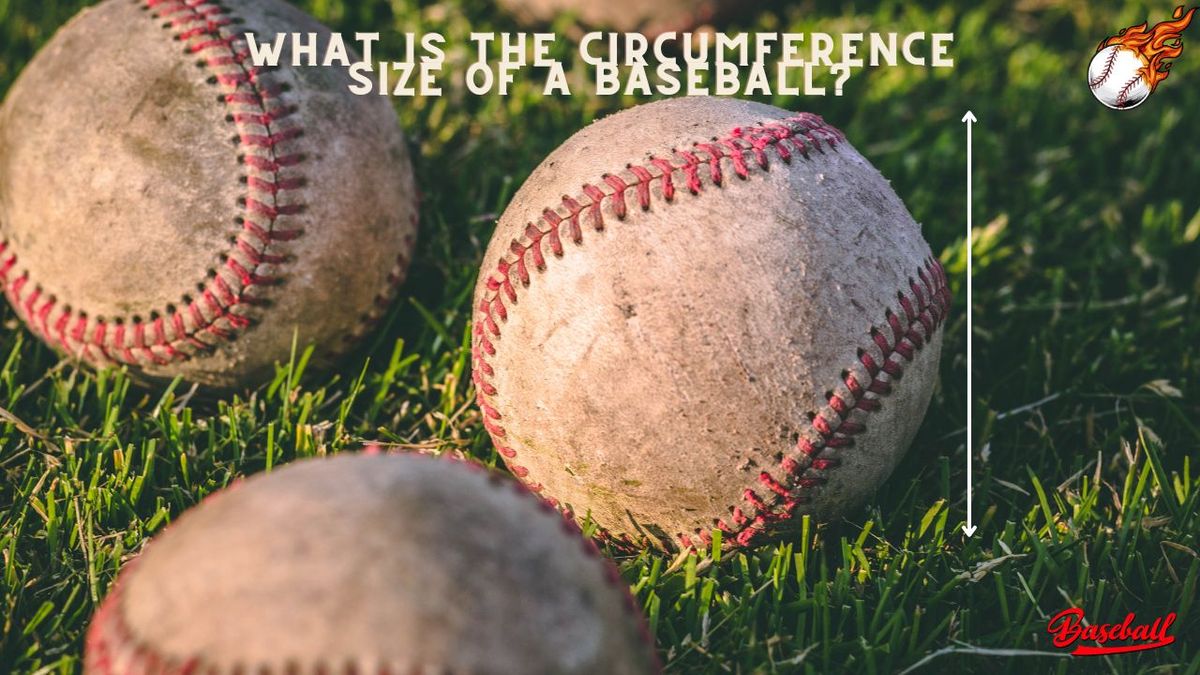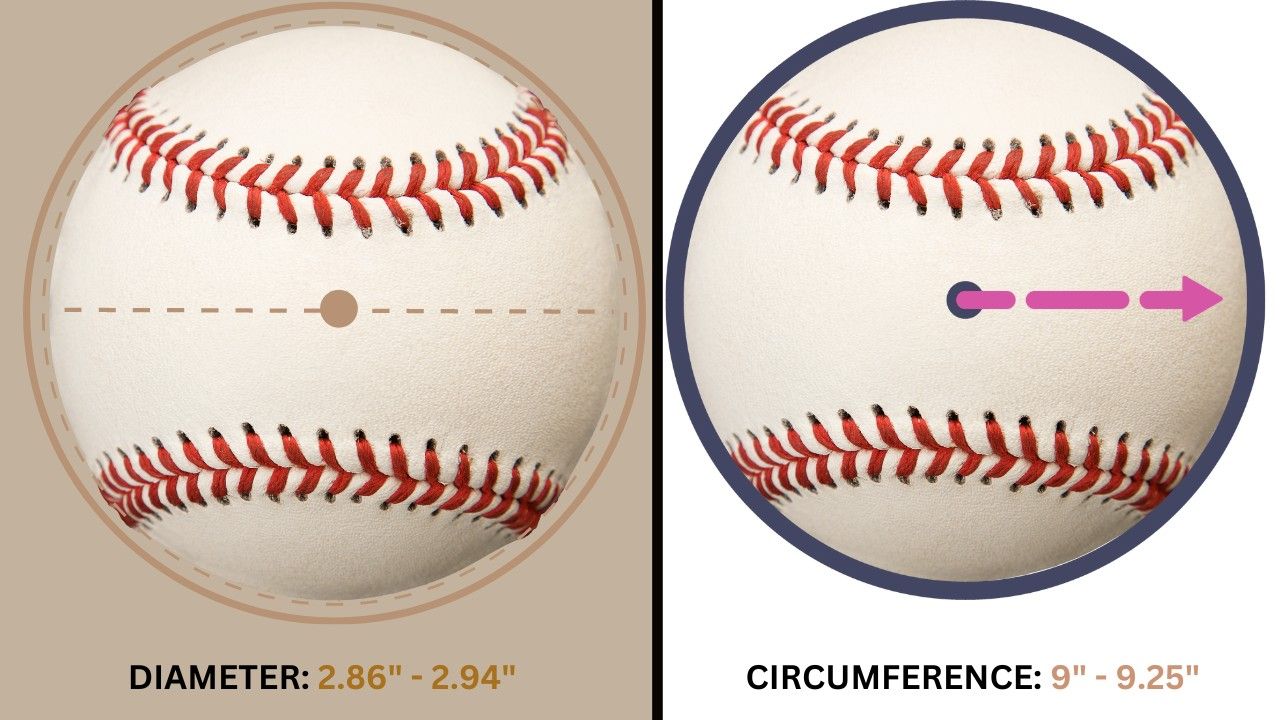What Is The Circumference Size Of A Baseball?
What Is The Circumference Size Of A Baseball? From its size to its monumental impact on the game, discover how a simple sphere becomes an integral part of the beloved sport's legacy.

Have you ever held a baseball in your hand and wondered if it's secretly auditioning for a role as the world's tiniest planet? Well, fear not, fellow curious minds, because we're about to unravel the delightful mystery that is the circumference size of a baseball!
Now, you might be expecting a profound revelation that will change the course of your life, but hey, even the smallest details can lead to the biggest "aha" moments. So, what's the scoop on the size of that trusty little orb that's been smacked, thrown, and caught by countless hands?
In short, a baseball's circumference size is about to get its moment in the spotlight, and we're here to roll out the dimensions with a sprinkle of knowledge and a dash of whimsy.
But wait, before you scamper off thinking, "How much can there be to know about a round object?"—let's pause and ponder. Did you know that this seemingly simple piece of sports equipment has a fascinating history?
It's been spun, stitched, and flung across fields with more passion than a squirrel chasing a nut. And while the answer to the circumference size of a baseball might seem straightforward, there's a backstory here that's waiting to delight you.
So, gather 'round, fellow seekers of random trivia and fascinating tidbits, as we embark on a journey into the heart of this compact enigma. Curious minds, unite!
How Big is a Baseball?
The dimensions of a baseball in bullet points:
- Diameter 2.86 to 2.94 inches (7.27 to 7.47 cm) around

- Circumference 9 to 9.25 inches (22.9 to 23.5 cm) approx
- Typically weight between 5 to 5.25 ounces (142 to 149 grams)
- Construction: Covered in leather or synthetic material, stitched with red thread in a figure-eight pattern
- Core: Made of cork and rubber mixture
These measurements might seem modest, but they're what transforms a simple sphere into the centerpiece of a beloved sport that has enchanted fans for generations.
Differences between ordinary baseball, rubber baseball, and soft baseball
Certainly, here are the key differences between ordinary baseballs, rubber baseballs, and soft baseballs in bullet points:
Ordinary Baseball
- Used in professional and amateur baseball leagues.
- Constructed with a leather or synthetic cover stitched with red thread.
- Has a solid cork and rubber core.
- Designed for traditional baseball gameplay.
- Used in competitive play and training for professional players.
Rubber Baseball
- Typically used for training, practice, and recreational purposes.
- Made entirely of rubber or a rubber-like material.
- Softer and more forgiving upon impact.
- Often used in batting cages or pitching machines.
- Offers a safer option for younger players or beginners.
Soft Baseball
- Primarily used for introductory baseball activities and youth leagues.
- Designed with a foam or padded core covered in soft material.
- Lightweight and less dense than traditional baseballs.
- Reduces the risk of injury and allows beginners to develop skills without fear of impact.
- Helps build confidence and hand-eye coordination in young players.
The History of Baseball
Early forms of baseball date back to 18th-century England, where games resembling baseball were played. Baseball evolved in the United States in the 19th century, with rules becoming standardized.
- 1845 Knickerbocker Rules: The Knickerbocker Base Ball Club in New York City introduced rules that formed the basis for modern baseball.
- 1869: First Professional Team: The Cincinnati Red Stockings became the first professional baseball team.
- 1876: National League: The National League (NL) was founded as the first major professional baseball league.
- 1901: American League: The American League (AL) emerged as a rival to the NL, leading to the establishment of the modern World Series in 1903.
- Integration: In 1947, Jackie Robinson became the first African American player in the modern major leagues, breaking the color barrier.
- Expansions: Baseball continued to grow, with the addition of new teams and expansion of leagues.
- Modern Era: The sport evolved with innovations in technology, stadiums, and player development.
- Global Popularity: Baseball gained international recognition, with the World Baseball Classic showcasing talent from around the world.
- Hall of Fame: The Baseball Hall of Fame was established to honor the sport's greatest players, managers, and contributors.
Famous Baseballs in History

Babe Ruth's 60th Home Run Ball (1927): Marked a historic achievement as Babe Ruth broke his record for the most home runs in a single season.
The "Shot Heard 'Round the World" (1951): Bobby Thomson's home run ball that won the National League pennant for the New York Giants in a dramatic playoff game against the Brooklyn Dodgers.
Hank Aaron's 715th Home Run Ball (1974): Symbolized breaking Babe Ruth's long-standing record for career home runs, a milestone moment in baseball history.
Bill Mazeroski's Walk-Off Home Run Ball (1960 World Series): Mazeroski's homer in Game 7 secured the Pittsburgh Pirates' championship victory against the New York Yankees.
Kirk Gibson's Walk-Off Home Run Ball (1988 World Series): Despite injuries, Gibson hit a dramatic pinch-hit walk-off home run in Game 1, inspiring the Los Angeles Dodgers to a World Series win.
Cal Ripken Jr.'s 2,131st Consecutive Game Ball (1995): Celebrated Ripken breaking Lou Gehrig's record for consecutive games played.
Barry Bonds' Record-Breaking Home Run Ball (2007): Bonds hit his 756th career home run, surpassing Hank Aaron's record, amid controversy over performance-enhancing drugs.
David Ortiz's Grand Slam Ball (2013 ALCS): Ortiz's grand slam in Game 2 of the ALCS ignited a rally and shifted the momentum in favor of the Boston Red Sox.
gCubs' 2016 World Series Final Out Ball: The Chicago Cubs' final out ball in Game 7 of the World Series ended a 108-year championship drought, making it a historic keepsake.
FAQs
What Is The Circumference Size of a Baseball?
Q: How many cm around is a baseball?
Answer: A standard baseball's circumference is approximately 23.5 cm (9.25 inches).
Q: What is the cubic size of a baseball?
Answer: The cubic size of a baseball is calculated by its diameter cubed (d³). The diameter of a standard baseball is around 7.47 cm (2.94 inches).
Calculating the cubic size
7.47 cm * 7.47 cm * 7.47 cm ≈ 416.87 cubic cm
So, the approximate cubic size of a baseball is around 416.87 cubic cm.
Q: What is the mass and radius of a baseball?
Answer: The mass and radius of a baseball can vary slightly depending on the specific baseball used, but here are the general measurements:
- Mass: Typically between 142 to 149 grams.
- Radius: Half of the diameter, which is around 1.435 to 1.47 inches (approximately 3.64 to 3.73 cm).
It's important to note that baseballs used in different leagues or levels of play might have slight variations in mass and dimensions, but the values provided above are within the standard range for a regulation baseball.
Q: What is the formula for baseball?
Answer: The term "formula for baseball" can refer to different aspects of the game, such as scoring, statistics, or physics. If you could provide more context or specify which aspect of baseball you're referring to, I'd be happy to help you with the relevant formula.
Q: What is the circumference and the weight of the ball?
Answer: The standard dimensions for a baseball used in professional and amateur leagues are as follows:
- Circumference: Approximately 9 to 9.25 inches (22.9 to 23.5 cm).
- Weight: Typically between 5 to 5.25 ounces (142 to 149 grams).
These measurements ensure consistency in the game and allow players to make accurate throws, pitches, and hits.
Key Takeaways!
As we wrap up our exploration into the miniature world of baseball dimensions, we've discovered that even the seemingly simple question of a baseball's circumference size unveils a universe of precision and tradition. What may appear as just a ball takes center stage in a game that has captured the hearts of players and fans for generations. From Babe Ruth's mighty swings to nail-biting pitches in the bottom of the ninth, the dimensions of a baseball hold more than just measurements—they hold the essence of a beloved sport that thrives on the magic of every play. So, the next time you hold a baseball in your hand, remember that you're cradling not just a ball, but a piece of history, competition, and the enduring spirit of America's pastime.
Must-Read Articles for Baseball Enthusiasts
- Baseball Training Apparel That Elevates Your Game to the Next Level!
- Stylish Baseball Bag That Will Make You Feel Like a Pro!
- Mind-Blowing Facts You Didn't Know About Baseball - Thanks to Baseball Reference!
- 4 Baseball Cleats That Will Have You Stealing Bases Like a Pro!
Sponsored By

